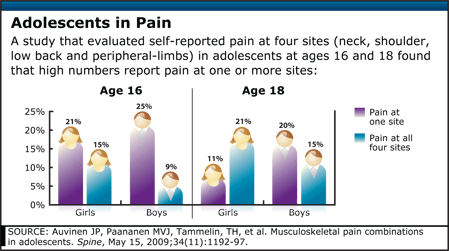According to a study published in the journal Spine, many more adolescents have pain in their neck, shoulders, low back, and limbs, then was previously assumed.
The study showed that nearly 25% of 16-year-old boys and girls and nearly 20% of 18-year-old boys and girls had pain in at least one of these sites.

I was 15-years-old the first time that I went to a chiropractor. That doctor’s visit changed my life. I had been involved in many minor traumas, as most children are. I fell off my bike, crashed skiing, and even fell out a 2nd story window when I was two (ask me about that one sometime). All those traumas that children and teens have, get stored in their muscles, joints, and tissues as restrictions of motion and can cause pain. Many times children just “play through it.” Additionally, they can often have difficulties describing pain to their parents. It isn’t always easy to describe where, how, and when parts of our body hurt.

When we correct joint fixations/subluxations and muscle tightness in children it usually only takes one or two visits and it allows the child’s growing body to not be hampered by imbalances and pain. If we never address a child’s tight muscles and joints then those imbalances become “locked in” to their adult tissues. I think this is why many of us have our “trouble areas” as adults which require numerous treatments, instead of just a couple adjustments as when treating children.
My first visit to the chiropractor helped me so much, I decided at age 15 that I wanted to devote my life to the chiropractic profession. I would be honored to have the opportunity to check your child’s joints for fixations and muscle imbalances. After I help you and your child understand what I found and answer any questions you have, we can get to work helping your son or daughter feel their best!
In Positive Motion,
Brant Pedersen (DC, CCSP)
